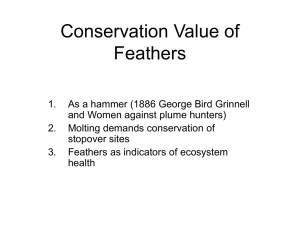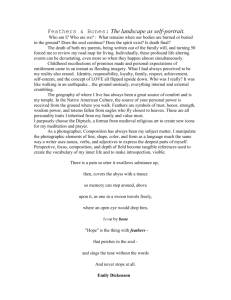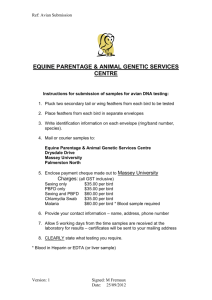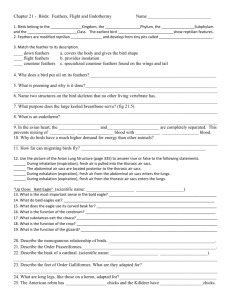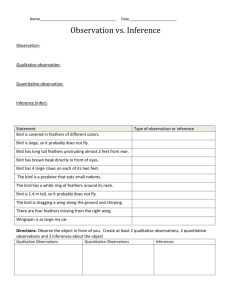Animal Coverings with Scope-On-A
advertisement
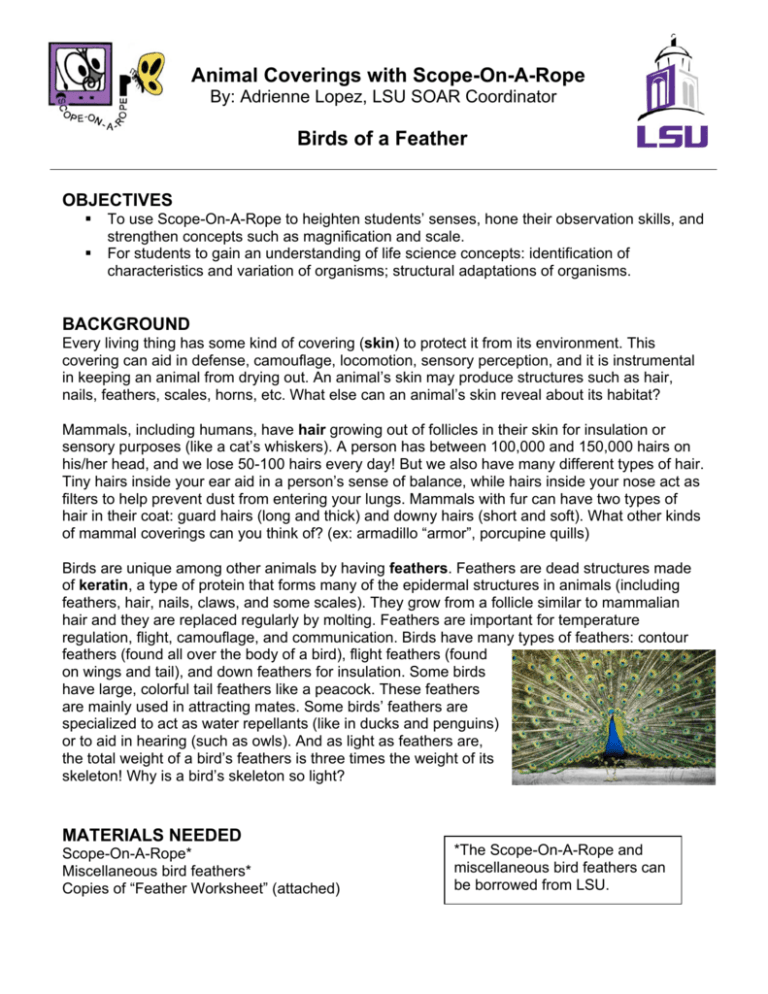
Animal Coverings with Scope-On-A-Rope By: Adrienne Lopez, LSU SOAR Coordinator Birds of a Feather OBJECTIVES To use Scope-On-A-Rope to heighten students’ senses, hone their observation skills, and strengthen concepts such as magnification and scale. For students to gain an understanding of life science concepts: identification of characteristics and variation of organisms; structural adaptations of organisms. BACKGROUND Every living thing has some kind of covering (skin) to protect it from its environment. This covering can aid in defense, camouflage, locomotion, sensory perception, and it is instrumental in keeping an animal from drying out. An animal’s skin may produce structures such as hair, nails, feathers, scales, horns, etc. What else can an animal’s skin reveal about its habitat? Mammals, including humans, have hair growing out of follicles in their skin for insulation or sensory purposes (like a cat’s whiskers). A person has between 100,000 and 150,000 hairs on his/her head, and we lose 50-100 hairs every day! But we also have many different types of hair. Tiny hairs inside your ear aid in a person’s sense of balance, while hairs inside your nose act as filters to help prevent dust from entering your lungs. Mammals with fur can have two types of hair in their coat: guard hairs (long and thick) and downy hairs (short and soft). What other kinds of mammal coverings can you think of? (ex: armadillo “armor”, porcupine quills) Birds are unique among other animals by having feathers. Feathers are dead structures made of keratin, a type of protein that forms many of the epidermal structures in animals (including feathers, hair, nails, claws, and some scales). They grow from a follicle similar to mammalian hair and they are replaced regularly by molting. Feathers are important for temperature regulation, flight, camouflage, and communication. Birds have many types of feathers: contour feathers (found all over the body of a bird), flight feathers (found on wings and tail), and down feathers for insulation. Some birds have large, colorful tail feathers like a peacock. These feathers are mainly used in attracting mates. Some birds’ feathers are specialized to act as water repellants (like in ducks and penguins) or to aid in hearing (such as owls). And as light as feathers are, the total weight of a bird’s feathers is three times the weight of its skeleton! Why is a bird’s skeleton so light? MATERIALS NEEDED Scope-On-A-Rope* Miscellaneous bird feathers* Copies of “Feather Worksheet” (attached) *The Scope-On-A-Rope and miscellaneous bird feathers can be borrowed from LSU. ACTIVITY 1. After reviewing some background information with your students, begin by examining your own covering with the 30x and 200x lenses. Does everyone’s skin and hair look the same? Can you see air bubbles inside the hairs on your head? How is the hair on your head different from the hair on your arm or in your ear? 2. Mammal skin has two structures to keep it from drying out: sweat glands and sebaceous (oil) glands. Use the 30x lens of SOAR to find the sweat glands on your fingertip [TIP: If you cannot see any glistening beads of sweat, try pressing the ON button to be sure the lighting is not polarized.] 3. Your nails are also made of keratin, like hair. Take a closer look if you dare! 4. Hand out samples of bird feathers for students to examine. For older students, see if they can tell whether it is a contour, flight, or downy feather. Contour Feather (both vanes are the same size) Flight Feather (one vane is much smaller than the other) Downy Feather (small, lacking structured vanes) 5. Make sure each student has a copy of the “feather worksheet”. Use the 30x lens of SOAR to examine the different bird feathers. Take a snap shot by pressing the REC button, and view by pressing the PLAY button. Have students draw the feather in the first box provided on the worksheet. Encourage them to really look at the image and draw as much detail as they can. 6. Take a picture of the same feather using the 200x lens. How much more detail can you see now? Have students draw this image in the second box on the worksheet. How does this structure help the bird in flight? Rachis (quill) barbule barb vane Anatomy of a Feather The anatomy of a feather consists of a main shaft (quill) with branches, called barbs. Each barb has smaller, interlocking projections called barbules. This configuration allows for a strong, yet flexible structure. LOUISIANA GRADE LEVEL EXPECTATIONS K 1st 2nd 3rd 4th 5th 7th Science As Inquiry 4, 10 5, 11 6, 12 6, 15 7, 17 29 29 Life Science 24, 25 32 30 35 41 29 9 ACTIVITY EXTENSIONS SCIENCE: Observe animals in the schoolyard or at home. Discuss the features of animals that are beneficial in their environment. Put animals into basic groups: mammal, reptile, bird, etc. Life Science GLE’s = PK: 24, Gr. K: 25; Gr. 1: 34; Gr. 2: 35; Gr. 3: 38-39; Gr. 4: 48 & 52; Gr. 5: 29 ELA: Read a book to your class about an animal whose covering helps it to be camouflaged from predators. Have students write a story about an animal in its habitat. Writing GLE’s = K: 20, 24-25; Gr. 1: 26, 29; Gr. 2: 21, 24; Gr. 3: 22, 24; Gr. 4: 20, 23; Gr. 5: 18, 21 ART: Have your students create an imaginary animal with a certain type of body covering and explain how this covering helps it to survive. They can draw it, sculpt with clay, or use other methods in the creation process. Visual Art Standards = VA-CE-E1 & E5 Websites for additional information: http://www.earthlife.net/birds/feathers.html (feather facts and diagrams) http://www.zoomschool.com/coloring (animal printouts) Third-grade students examine a bird feather with the Scope-On-A-Rope. This work was supported by a Howard Hughes Medical Institute grant through the Undergraduate Biological Sciences Education Program to Louisiana State University. Name ___________________________ Date __________________ Feather Worksheet Draw what a bird feather looks like when magnified a little (30x lens). Draw what a bird feather looks like when magnified a lot (200x lens). One cool thing I didn’t know about bird feathers until I looked at one magnified is: ______________________________________________
